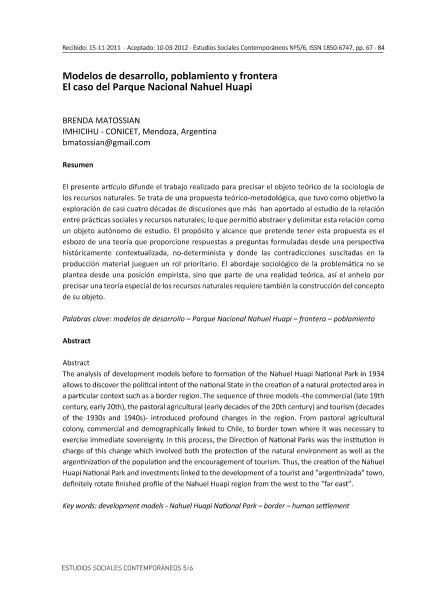Mostrar el registro sencillo del ítem
dc.contributor.author
Matossian, Brenda

dc.date.available
2018-04-23T21:54:55Z
dc.date.issued
2012-03-10
dc.identifier.citation
Matossian, Brenda; Modelos de desarrollo, poblamiento y frontera. El caso del Parque Nacional Nahuel Huapi; Instituto Multidisciplinario de Historia y Ciencias Humanas; Estudios Sociales Contemporáneos; 5-6; 10-3-2012; 67-84
dc.identifier.issn
1850-6747
dc.identifier.uri
http://hdl.handle.net/11336/43177
dc.description.abstract
El análisis de los modelos de desarrollo previos a la formación del Parque Nacional Nahuel Huapi en 1934 permite descubrir la intencionalidad política del Estado nacional en la creación del área natural protegida en un contexto particular como es el de una región fronteriza. La sucesión de tres modelos -el comercial (fines del siglo XIX, primeros años del XX), el agrícola pastoril (primeras décadas del siglo XX) y el turístico (décadas del treinta y cuarenta)- introduce profundos cambios en la región. De colonia agrícola pastoril, vinculada aún comercial y demográficamente a Chile, a localidad de frontera donde era necesario ejercer soberanía inmediata. En este proceso, la Dirección de Parques Nacionales fue la institución a cargo de este cambio que implicaba tanto la protección del medio natural como la argentinización de la población y el impulso del turismo. Así, la creación del Parque Nacional Nahuel Huapi y las inversiones vinculadas al desarrollo de una ciudad turística y “argentinizada” terminaron de rotar definitivamente el perfil de de la región de Nahuel Huapi desde el Oeste, hacia el “lejano Este”.
dc.description.abstract
The analysis of development models before to formation of the Nahuel Huapi National Park in 1934 allows to discover the political intent of the national State in the creation of a natural protected area in a particular context such as a border region. The sequence of three models -the commercial (late 19th century, early 20th), the pastoral agricultural (early decades of the 20th century) and tourism (decades of the 1930s and 1940s)- introduced profound changes in the region. From pastoral agricultural colony, commercial and demographically linked to Chile, to border town where it was necessary to exercise immediate sovereignty. In this process, the Direction of National Parks was the institution in charge of this change which involved both the protection of the natural environment as well as the argentinization of the population and the encouragement of tourism. Thus, the creation of the Nahuel Huapi National Park and investments linked to the development of a tourist and "argentinizada" town, definitely rotate finished profile of the Nahuel Huapi region from the west to the "far east".
dc.format
application/pdf
dc.language.iso
spa
dc.publisher
Instituto Multidisciplinario de Historia y Ciencias Humanas
dc.rights
info:eu-repo/semantics/openAccess
dc.rights.uri
https://creativecommons.org/licenses/by-nc-sa/2.5/ar/
dc.subject
Modelo de Desarrollo
dc.subject
Parque Nacional Nahuel Huapi
dc.subject
Frontera
dc.subject
Poblamiento
dc.subject.classification
Ciencias Medioambientales

dc.subject.classification
Geografía Económica y Social

dc.subject.classification
CIENCIAS SOCIALES

dc.title
Modelos de desarrollo, poblamiento y frontera. El caso del Parque Nacional Nahuel Huapi
dc.title
Development models, human settlement and border the nahuel huapi national park case
dc.type
info:eu-repo/semantics/article
dc.type
info:ar-repo/semantics/artículo
dc.type
info:eu-repo/semantics/publishedVersion
dc.date.updated
2018-04-16T14:45:57Z
dc.journal.number
5-6
dc.journal.pagination
67-84
dc.journal.pais
Argentina

dc.journal.ciudad
Mendoza
dc.description.fil
Fil: Matossian, Brenda. Consejo Nacional de Investigaciones Científicas y Técnicas. Oficina de Coordinación Administrativa Saavedra 15. Instituto Multidisciplinario de Historia y Ciencias Humanas; Argentina
dc.journal.title
Estudios Sociales Contemporáneos
dc.relation.alternativeid
info:eu-repo/semantics/altIdentifier/url/http://bdigital.uncu.edu.ar/app/navegador/?idobjeto=4970
Archivos asociados
